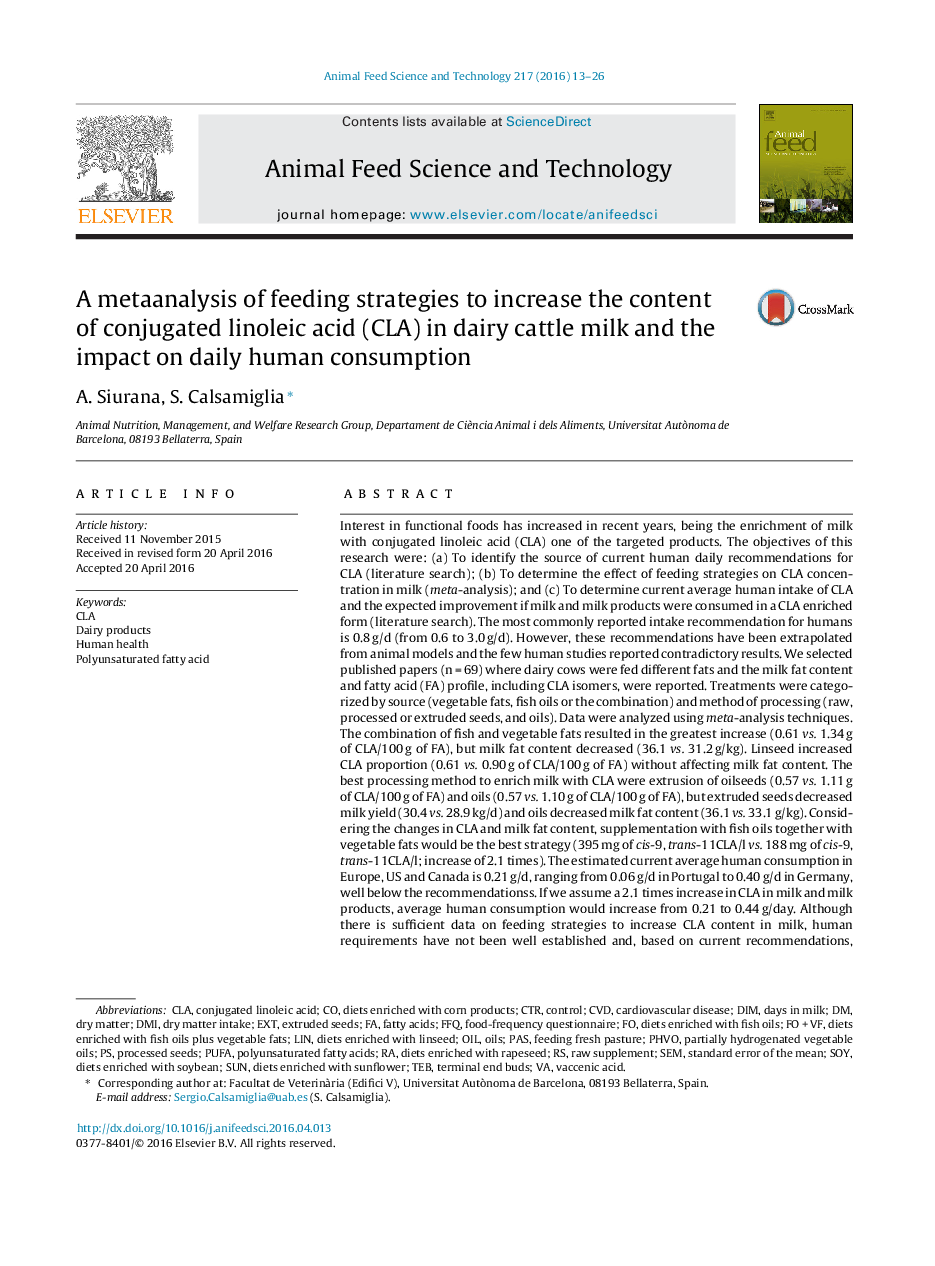| کد مقاله | کد نشریه | سال انتشار | مقاله انگلیسی | نسخه تمام متن |
|---|---|---|---|---|
| 2419274 | 1552368 | 2016 | 14 صفحه PDF | دانلود رایگان |

• Milk enriched with conjugated linoleic acid (CLA) is an interest functional food.
• The most commonly reported intake recommendation for humans is 0.8 g/d.
• Feeding fat supplements to dairy cattle increase the content of CLA in milk.
• The estimated current average human consumption of CLA in different countries is 0.21 g/d.
• CLA-enriched form products were consumed, human intake would increase to 0.44 g/d.
Interest in functional foods has increased in recent years, being the enrichment of milk with conjugated linoleic acid (CLA) one of the targeted products. The objectives of this research were: (a) To identify the source of current human daily recommendations for CLA (literature search); (b) To determine the effect of feeding strategies on CLA concentration in milk (meta-analysis); and (c) To determine current average human intake of CLA and the expected improvement if milk and milk products were consumed in a CLA enriched form (literature search). The most commonly reported intake recommendation for humans is 0.8 g/d (from 0.6 to 3.0 g/d). However, these recommendations have been extrapolated from animal models and the few human studies reported contradictory results. We selected published papers (n = 69) where dairy cows were fed different fats and the milk fat content and fatty acid (FA) profile, including CLA isomers, were reported. Treatments were categorized by source (vegetable fats, fish oils or the combination) and method of processing (raw, processed or extruded seeds, and oils). Data were analyzed using meta-analysis techniques. The combination of fish and vegetable fats resulted in the greatest increase (0.61 vs. 1.34 g of CLA/100 g of FA), but milk fat content decreased (36.1 vs. 31.2 g/kg). Linseed increased CLA proportion (0.61 vs. 0.90 g of CLA/100 g of FA) without affecting milk fat content. The best processing method to enrich milk with CLA were extrusion of oilseeds (0.57 vs. 1.11 g of CLA/100 g of FA) and oils (0.57 vs. 1.10 g of CLA/100 g of FA), but extruded seeds decreased milk yield (30.4 vs. 28.9 kg/d) and oils decreased milk fat content (36.1 vs. 33.1 g/kg). Considering the changes in CLA and milk fat content, supplementation with fish oils together with vegetable fats would be the best strategy (395 mg of cis-9, trans-11CLA/l vs. 188 mg of cis-9, trans-11CLA/l; increase of 2.1 times). The estimated current average human consumption in Europe, US and Canada is 0.21 g/d, ranging from 0.06 g/d in Portugal to 0.40 g/d in Germany, well below the recommendationss. If we assume a 2.1 times increase in CLA in milk and milk products, average human consumption would increase from 0.21 to 0.44 g/day. Although there is sufficient data on feeding strategies to increase CLA content in milk, human requirements have not been well established and, based on current recommendations, they are unattainable even if all milk and milk products were consumed as CLA enriched products.
Journal: Animal Feed Science and Technology - Volume 217, July 2016, Pages 13–26